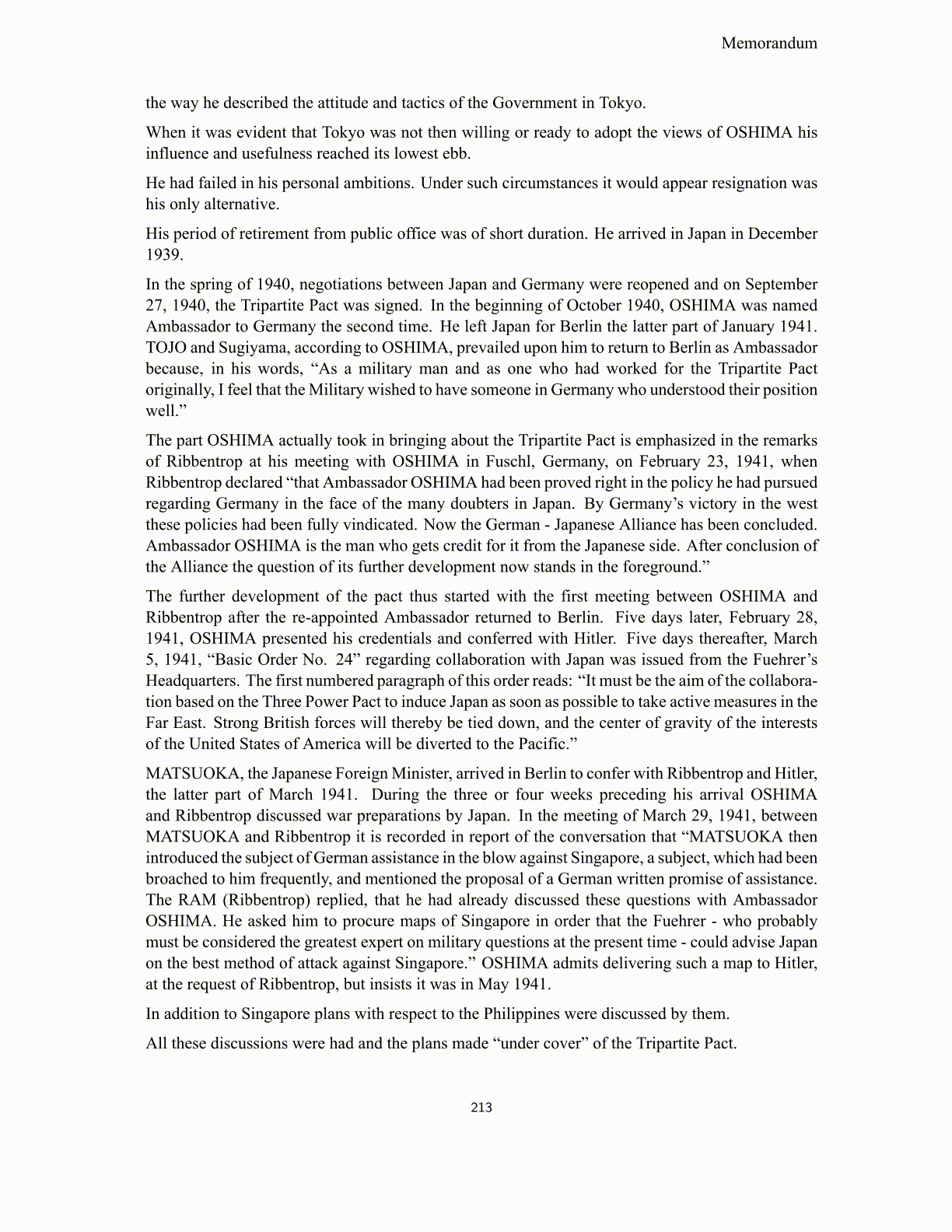
Memorandum the way he described the attitude and tactics of the Government in Tokyo. When it was evident that Tokyo was not then willing or ready to adopt the views of OSHIMA his influence and usefulness reached its lowest ebb. He had failed in his personal ambitions. Under such circumstances it would appear resignation was his only alternative. His period of retirement from public office was of short duration. He arrived in Japan in December 1939. In the spring of 1940, negotiations between Japan and Germany were reopened and on September 27, 1940, the Tripartite Pact was signed. In the beginning of October 1940, OSHIMA was named Ambassador to Germany the second time. He left Japan for Berlin the latter part of January 1941. TOJO and Sugiyama, according to OSHIMA, prevailed upon him to return to Berlin as Ambassador because, in his words, “As a military man and as one who had worked for the Tripartite Pact originally, I feel that the Military wished to have someone in Germany who understood their position well.” The part OSHIMA actually took in bringing about the Tripartite Pact is emphasized in the remarks of Ribbentrop at his meeting with OSHIMA in Fuschl, Germany, on February 23, 1941, when Ribbentrop declared “that Ambassador OSHIMA had been proved right in the policy he had pursued regarding Germany in the face of the many doubters in Japan. By Germany’s victory in the west these policies had been fully vindicated. Now the German - Japanese Alliance has been concluded. Ambassador OSHIMA is the man who gets credit for it from the Japanese side. After conclusion of the Alliance the question of its further development now stands in the foreground.” The further development of the pact thus started with the first meeting between OSHIMA and Ribbentrop after the re-appointed Ambassador returned to Berlin. Five days later, February 28, 1941, OSHIMA presented his credentials and conferred with Hitler. Five days thereafter, March 5, 1941, “Basic Order No. 24” regarding collaboration with Japan was issued from the Fuehrer’s Headquarters. The first numbered paragraph of this order reads: “It must be the aim of the collabora- tion based on the Three Power Pact to induce Japan as soon as possible to take active measures in the Far East. Strong British forces will thereby be tied down, and the center of gravity of the interests of the United States of America will be diverted to the Pacific.” MATSUOKA, the Japanese Foreign Minister, arrived in Berlin to confer with Ribbentrop and Hitler, the latter part of March 1941. During the three or four weeks preceding his arrival OSHIMA and Ribbentrop discussed war preparations by Japan. In the meeting of March 29, 1941, between MATSUOKA and Ribbentrop it is recorded in report of the conversation that “MATSUOKA then introduced the subject of German assistance in the blow against Singapore, a subject, which had been broached to him frequently, and mentioned the proposal of a German written promise of assistance. The RAM (Ribbentrop) replied, that he had already discussed these questions with Ambassador OSHIMA. He asked him to procure maps of Singapore in order that the Fuehrer - who probably must be considered the greatest expert on military questions at the present time - could advise Japan on the best method of attack against Singapore.” OSHIMA admits delivering such a map to Hitler, at the request of Ribbentrop, but insists it was in May 1941. In addition to Singapore plans with respect to the Philippines were discussed by them. All these discussions were had and the plans made “under cover” of the Tripartite Pact. 213